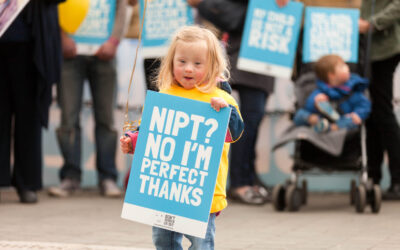The most recent abortion statistics released by the Department of Health today show a 42% increase in abortions for Down’s syndrome since 2008.
The statistics show that there were 618 abortions for Down’s syndrome in 2018. This now brings it to a 42% increase in abortion for Down’s syndrome in the last ten years with figures rising from 436 in 2008.
The statistics also show a 64% increase in abortions after 24-weeks gestation for Down’s syndrome, up to 18 from 11 in 2017. Under the current law, abortion is allowed up to birth if a baby has a disability including Down’s syndrome.
This is likely to be attributed to the private availability of cfDNA testing (otherwise known as NIPT) which has already been predicted to increase the numbers of children with Down’s syndrome being screened out by termination. The beginning of the roll-out of these tests on the NHS, who were already recommending the private tests to expectant mothers, may also be having an impact on the increasing numbers of terminations.
This situation is set to get far worse as the Government still intends to move ahead with proposals to implement cfDNA testing into the Fetal Anomaly Screening Programme.
Proponents of the test have glossed over the fact that a National Screening Committee pilot study predicts the new screening will detect 102 more babies with Down’s syndrome every year in England and Wales. Based on the most recent statistics, 90% of pregnancies are aborted after the baby is found to have Down’s syndrome, this would mean an increase of 92 abortions for Down’s syndrome annually.
That reduction equates to an overall decline of Down’s syndrome live births by 13% and would lead to a corresponding reduction in the number of people with the condition. Such an outcome is likely to have a profoundly negative effect on the community of people with Down’s Syndrome.
The Don’t Screen Us Out campaign, a coalition of Down’s syndrome advocacy groups, are urging Matt Hancock to delay the implementation of the new test until there has been full consultation with the community of people with Down’s syndrome and medical reforms have been introduced which address the unresolved ethical issues of screening.
Lynn Murray, spokeswoman for the Don’t Screen Us Out campaign said:
“As a mother of a 19-year-old daughter who has Down’s syndrome, I see every day the unique value she brings to our family and the positive impact she has on others around her.
It is deeply concerning that despite the leaps that advocacy groups have made in raising awareness in support of people with Down’s syndrome, abortion in the case of Down’s syndrome is still so commonplace and widespread in the UK. In fact, we hear from parents all the time how abortion was repeatedly presented to them in the hospital as an obvious solution following the receipt of the news that their baby had Down’s syndrome.
With the Government set to follow through on proposals to make private screening tests available on the NHS, projections show that there will likely be a steep increase in the numbers of children with Down’s syndrome screened out by termination unless there is an immediate intervention.
In England and Wales, 90% of babies diagnosed with Down’s syndrome are aborted. Northern Ireland currently has a very different approach when a baby is found to have Down’s syndrome. Disability-selective abortion for Down’s syndrome is illegal and there is a culture of accepting and supporting people with disabilities rather than eliminating them.
This is reflected directly in recent official figures showing that almost 100% of babies found to have Down’s syndrome in Northern Ireland are born. This greatly contrasts with the 90% termination rate for Down’s syndrome from other parts of the UK.”
ENDS
- For more information on the Don’t Screen Us Out campaign, see our website www.dontscreenusout.org or email info@dontscreenusout.org
- For interviews, contact Don’t Screen Us Out spokesperson Lynn Murray on 0784 0966 736 or email info@dontscreenusout.org
- The latest Abortion Statistics for England and Wales 2018 are available here.



